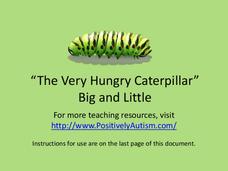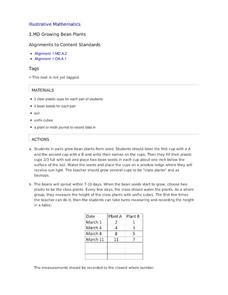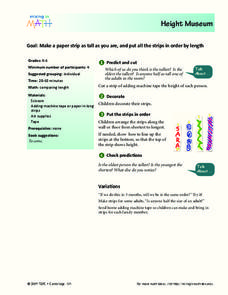Positively Autism
The Very Hungry Caterpillar Big and Little Activity
A big caterpillar, a little caterpillar. A big butterfly, a little butterfly. Images from Eric Carle's The Very Hungry Caterpillar model for learners with autism the difference between big and little.
K20 LEARN
Cumbersome Cubes
Halving is not always so simple. Small groups build a cube and then determine how to construct a cube that is half the size. Groups create two cubes, one that is the correct size and another that would be an alternative solution. To...
Exploratorium
Life Size - Explore the Size and Scale of Microscopic Biology
Compare sizes of microscopic items. Given a set of labels of microscopic objects, pupils try to place them in order from smallest to largest. Scholars then compare their lists to the actual comparisons along with the measurements of the...
National Nanotechnology Infrastructure Network
Big vs. Little - Macro to Micro Lesson 1
Small and large are relative terms; what's the best way to quantify them? Young scientists take on that challenge as they complete an interactive activity to explore size. They build structures during their exploration and begin using...
CK-12 Foundation
Properties of Rational Numbers: Lollipop Trees
A six-question interactive takes mathematicians to Lollipop Land where they manipulate lollipop trees to make equivalent ratios. Question types include multiple-choice, true or false, and a discussion.
Magic of Physics
Scale of the Universe I
From quantum foam to the universe itself, plus everything in between, what is the scale of the world around us? Inquisitive physicists grapple with the proportions of all things great and small using a fascinating interactive. Scholars...
Serendip
Diffusion and Cell Size and Shape
Is your class ready to size up the topic of diffusion? Help them get cell shape savvy with a well-written handout. The resource covers how substances such as oxygen passively move through the cell membrane and how cell size and shape...
McGraw Hill
Binary Stars Interactive
A celestial body's distance from Earth makes studying its characteristics much more difficult. Learn how scientists use indirect measures to determine the size of stars. The interactive activity has individuals adjust the size of binary...
Laboratory for Atmospheric and Space Physics
Jupiter’s Relative Size
How do you properly illustrate the extreme size difference between two planets—Earth and Jupiter? With the help of jellybeans, of course! Create a scale model of Jupiter's mass compared to Earth using a fishbowl, 1,400 beans, and a dixie...
Houghton Mifflin Harcourt
Down on the Farm: English Language Development Lessons (Theme 8)
Down on the Farm is the theme of this series of ESL lessons designed to support reading, speaking, and listening skills. Over three weeks, your learners will have the opportunity to sing songs, play guessing games, create masks, role...
Positively Autism
"The Napping House" Big and Little
The dog is big. The mouse is little. Using vocabulary words introduced in the previous lesson, kids read, or are read, sentences and examine images that contrast big and little.
Positively Autism
"The Napping House" Vocabulary
House, sleeping, bed, granny, child, dog, cat, mouse, flea. Introduce these vocabulary words before a reading of The Napping House.
Oddrobo Software
King of Math Junior
Do your students have what it takes to be the king of math? Find out with this fun skills practice game that covers a wide range of topics from counting and basic operations to measurement and fractions.
Illustrative Mathematics
Growing Bean Plants
Plant growth experiments offer rich, cross-curricular learning opportunities that can really excite and engage young learners. In this series, children work in pairs planting, measuring, and comparing the height of bean plants in order...
Illustrative Mathematics
Size Shuffle
In the eyes of children the world is a simple place, objects are either big or small. This simple activity aims to expand the comparison language of young mathematicians as they use the words taller and shorter to compare their height...
Illustrative Mathematics
Which Weighs More? Which Weighs Less?
Expand the the comparative language of young mathematicians with a hand-on weight measurement activity. Working independently or in pairs, children compare the weight of large wooden blocks to various other classroom objects, recording...
Curated OER
Height Museum
Here is an engaging instructional activity which invites learners to cut a strip of adding machine tape that is their height. They decorate their strip, arrange the strips from shortest to longest, and then discuss predictions.
Curated OER
Find the Shorter Item
In this early childhood size comparison worksheet, young scholars examine the 4 groupings of objects and circle the shortest object in each of the 4 groupings.
Curated OER
Comparing Sizes
In this early childhood size comparison activity, students examine the 5 pairs of food items and circle the biggest food item in each of the 5 pairs.
Curated OER
Identify the Smallest Object
In this early childhood size comparison worksheet, young scholars examine the 4 groupings of vegetables and circle the smallest vegetable in each of the 4 groupings.
Curated OER
Identify the Biggest Object
In this early childhood size comparison worksheet, students examine the 4 groupings of fruit and circle the biggest fruit in each of the 4 groupings.
Curated OER
Small
In this visual discrimination worksheet, students analyze the two pictures of animals. Students circle the picture in each row that is the smallest. There are 5 questions.
Curated OER
Identify More
In this early childhood size comparison activity worksheet, students examine 6 boxes with 2 groupings of objects and circle the grouping in each box that has more items than the other grouping.
Curated OER
Measuring Scavenger Hunt
Learners participate in a measuring scavenger hunt. Students choose items around the room to estimate and measure. Learners try measuring with their hands and compare with other students who did the same. Learners discuss why their...

























